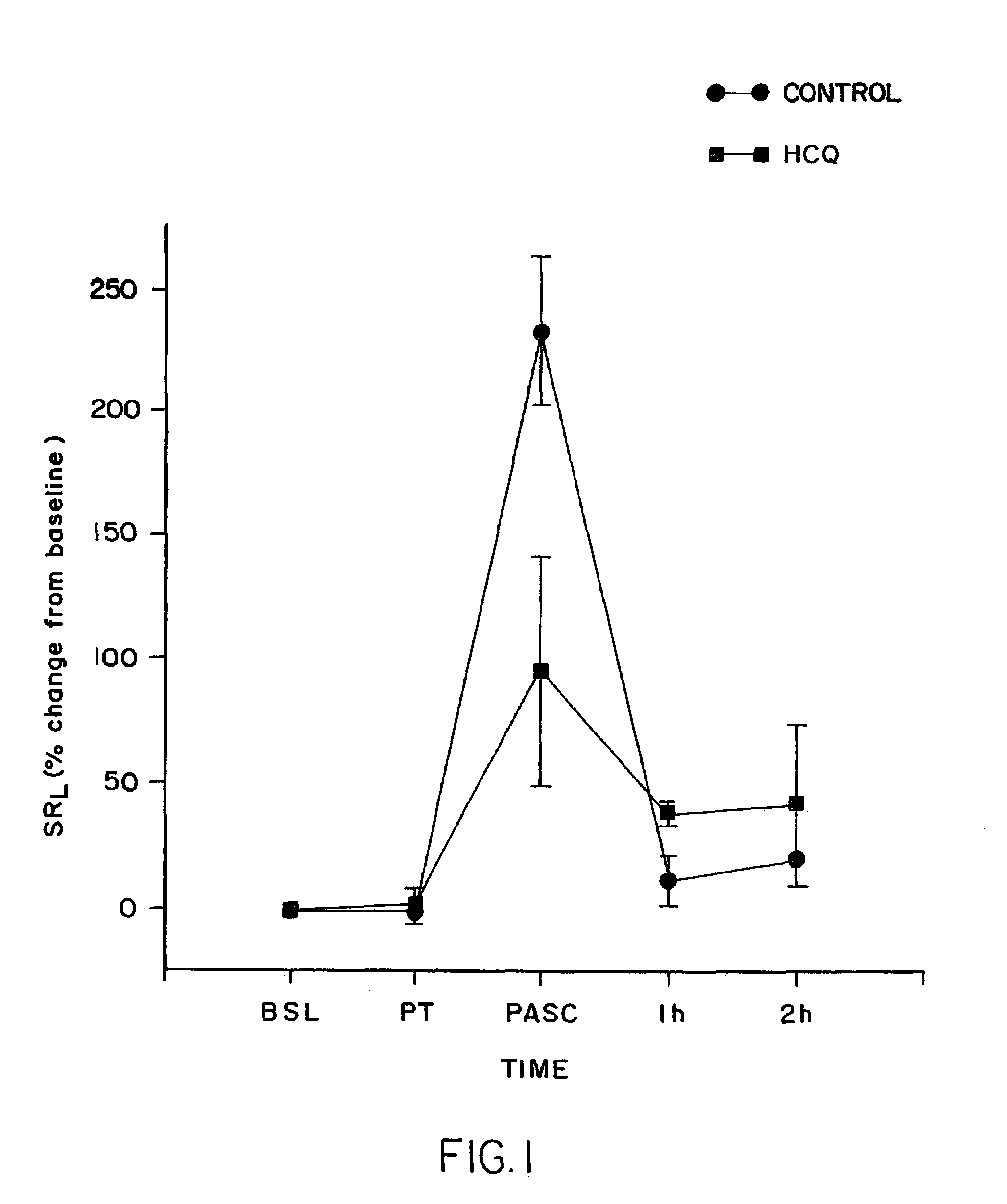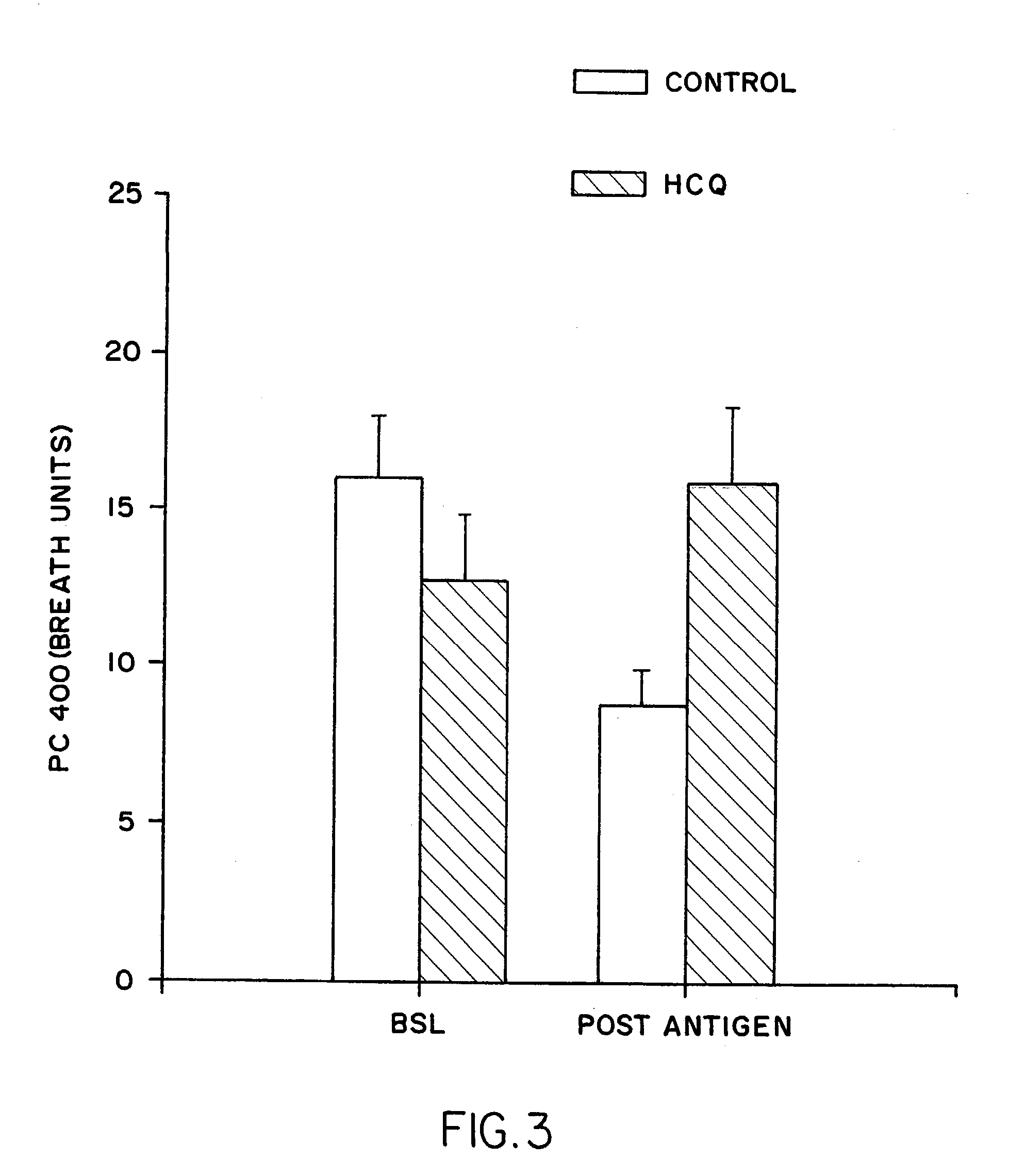Uses for anti-malarial therapeutic agents
a technology of anti-malarial drugs and therapeutic agents, which is applied in the direction of aerosol delivery, spray delivery, immunological disorders, etc., can solve the problems of chronic irreversible airway obstruction, complicated oral systemic corticosteroid treatment, and permanent airway remodeling
- Summary
- Abstract
- Description
- Claims
- Application Information
AI Technical Summary
Benefits of technology
Problems solved by technology
Method used
Image
Examples
example 1
[0158]At 3 to 4 days before treatment was begun, baseline airway responsiveness, to aerosol carbachol (i.e., PC400) was determined and a baseline bronchial biopsy performed. Then at 4 days before antigen challenge, the asthmatic sheep began treatment with 30 mg an average of 0.78 mg / kg HCQ (30 mg / animal, 30 mg in 5 cc Normal Saline, given as aerosol). The animals were treated two times a day for 3 days and then, on the fourth day, at 0.5 hours before antigen challenge and again at 4 hours after challenge. On the antigen-challenge day, SRL was measured and the animals were than treated with HCQ designated compound. SRL was remeasured 0.5 h after treatment (just before challenge) and the animals were then challenged with antigen. SRL was then remeasured immediately after.
[0159]The results were compared to those obtained with the sheep to which PBS were administered in lieu of the drug and challenged in the same fashion. The results are tabulated in Table 1 and graphically represented ...
example 2
[0161]In a second experiment, the procedure of Example 1 was followed except the animals received a dosage of an average of 40 mg b.i.d. (2 mg / kg / day) of HCQ for 3 days. On the fourth day, they received an additional treatment one-half hour prior to antigen challenge. While acute reactions were not inhibited, late phase asthmatic reactions were virtually completely blocked in the drug-treatment group. Specific resistance in the control group peaked at an increase of a mean of 148% at 6.5 hours, compared to a mean increase of only 14% in the drug-treated group. See FIG. 2 and Table 2.
[0162]Underlining the potent effect of the HCQ treatment, a 24 hour post-antigen challenge carbachol reactivity (PC 400 as measured in breath units) increased in the control group by 50% as anticipated, but actually fell in the treatment group from 12.74 to 15.82 units (see FIG. 3).
[0163]
TABLE 1Specific resistance following antigen challenge (Example 1)P-P-P-P-BSLN.pl / dgpl / dgpl / dgpl / dgP-ASCP-ASC+1 HR+1 H...
example 3
METHODS OF EXAMPLE 3
[0165]All procedures were approved by the Mount Sinai Medical Center Animal Research Committee, which is responsible for assuring the humane care and use of experimental animals. The sheep used for this study had previously been shown to develop early and late airway responses and airway hyperresponsiveness to inhaled carbachol following inhalation challenge with Ascaris suum antigen. During the chronic treatment trail, venous blood samples were obtained from the external jugular vein for the determination of plasma compound concentrations. Samples were obtained as baseline (pre-dosing), and, then, before dosing on days 8, 15, 22, 29 and after dosing had stopped on day 43.
[0166]Measurement of Airway Mechanics: The unsedated sheep were restrained in a cart in the prone position with their heads immobilized. After topical anesthesia of the nasal passages with 2%-lidocaine solution, a balloon catheter was advanced through one nostril into the lower esophagus. The an...
PUM
| Property | Measurement | Unit |
|---|---|---|
| Fraction | aaaaa | aaaaa |
| Fraction | aaaaa | aaaaa |
| Fraction | aaaaa | aaaaa |
Abstract
Description
Claims
Application Information
 Login to View More
Login to View More - R&D
- Intellectual Property
- Life Sciences
- Materials
- Tech Scout
- Unparalleled Data Quality
- Higher Quality Content
- 60% Fewer Hallucinations
Browse by: Latest US Patents, China's latest patents, Technical Efficacy Thesaurus, Application Domain, Technology Topic, Popular Technical Reports.
© 2025 PatSnap. All rights reserved.Legal|Privacy policy|Modern Slavery Act Transparency Statement|Sitemap|About US| Contact US: help@patsnap.com



